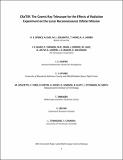CRaTER: The Cosmic Ray Telescope for the Effects of Radiation Experiment on the Lunar Reconnaissance Orbiter Mission
Author(s)
Spence, H. E.; Case, A. W.; Golightly, M. J.; Heine, T.; Larsen, B. A.; Blake, J. B.; Caranza, P.; Crain, W. R.; George, J.; Lalic, M.; Lin, A.; Looper, M. D.; Mazur, J. E.; Salvaggio, D.; Kasper, J. C.; Stubbs, T. J.; Doucette, M.; Ford, Peter Gerald; Foster, Richard F.; Goeke, Robert F.; Gordon, Dorothy; Klatt, Brian W.; O'Connor, J.; Smith, M.; Onsager, T.; Zeitlin, C.; Townsend, L. W.; Charara, Y.; ... Show more Show less
DownloadArticle (3.356Mb)
PUBLISHER_POLICY
Publisher Policy
Article is made available in accordance with the publisher's policy and may be subject to US copyright law. Please refer to the publisher's site for terms of use.
Terms of use
Metadata
Show full item recordAbstract
The Cosmic Ray Telescope for the Effects of Radiation (CRaTER) on the Lunar Reconnaissance Orbiter (LRO) characterizes the radiation environment to be experienced by humans during future lunar missions. CRaTER measures the effects of ionizing energy loss in matter due to penetrating solar energetic protons (SEP) and galactic cosmic rays (GCR), specifically in silicon solid-state detectors and after interactions with tissue-equivalent plastic (TEP), a synthetic analog of human tissue. The CRaTER investigation quantifies the linear energy transfer (LET) spectrum in these materials through direct measurements with the lunar space radiation environment, particularly the interactions of ions with energies above 10 MeV, which penetrate and are detected by CRaTER. Combined with models of radiation transport through materials, CRaTER LET measurements constrain models of the biological effects of ionizing radiation in the lunar environment as well as provide valuable information on radiation effects on electronic systems in deep space. In addition to these human exploration goals, CRaTER measurements also provide new insights on the spatial and temporal variability of the SEP and GCR populations and their interactions with the lunar surface. We present here an overview of the CRaTER science goals and investigation, including: an instrument description; observation strategies; instrument testing, characterization, and calibration; and data analysis, interpretation, and modeling plans.
Date issued
2010-01Department
MIT Kavli Institute for Astrophysics and Space ResearchJournal
Space Science Reviews
Publisher
Springer Netherlands
Citation
Spence, H. E. et al. “CRaTER: The Cosmic Ray Telescope for the Effects of Radiation Experiment on the Lunar Reconnaissance Orbiter Mission.” Space Science Reviews 150.1-4 (2010) : 243-284.
Version: Author's final manuscript
ISSN
0038-6308
1572-9672